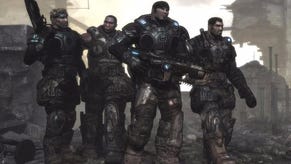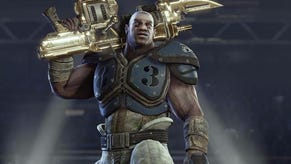Digital Foundry vs. Gears of War 3
Finishing the fight.
First seen in Batman: Arkham Asylum, Darkworks' middleware was integrated into Unreal Engine 3 a while back and made its debut in Ninja Theory's Enslaved, via the Pigsy's Perfect Ten DLC, where the tech lived up to its claims of providing a 3DTV experience with virtually no performance impact whatsoever (on 360 at least, the early PS3 HDMI 1.4 implementation did have some frame-rate issues).
TriOviz works on the principle of rendering a single view, allocating that to the left eye and then using a technique known as reprojection to extrapolate out the right eye view based on info culled from the depth buffer used in rendering the scene. The advantage is that it's lightning-fast, as Enslaved demonstrates rather nicely. The disadvantage is that because only one eye's worth of detail is being rendered, the other eye has streaky artifacts where no visual information specific to that view has been generated.
Based on our observations, TriOviz has taken a hit to its performance, but the suggestion is that extra processing time is used minimise the reprojection artifacts and tidy up other issues. To illustrate, below are two screenshots taken from cut-scenes - one from Enslaved (running in full 720p on PS3, but the same principle applies), the other from Gears of War 3. In both cases, we're highlighting the reprojected eye's view. On the Enslaved shot, you can see that detail to the right of Monkey and on the foreground environment objects has the streaky reprojection artifacts. On the Gears shot, such artifacts are very difficult to spot and are very difficult indeed to notice during the heat of gameplay, looking like more of a haze effect. This isn't true stereoscopy in the way that Uncharted 3 or Resistance 3 handle their 3D, but certainly based on what we've played on all three games, Gears 3 is just as viable an experience.
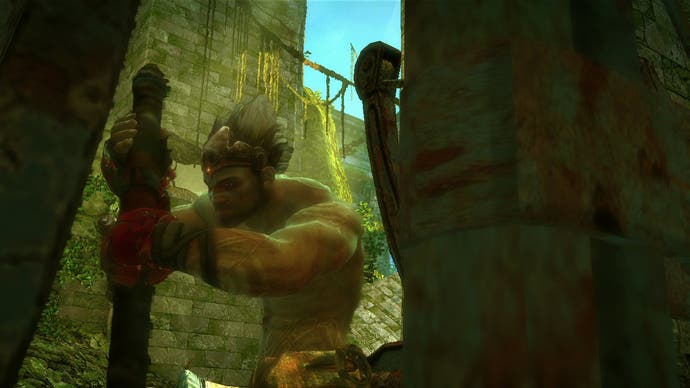
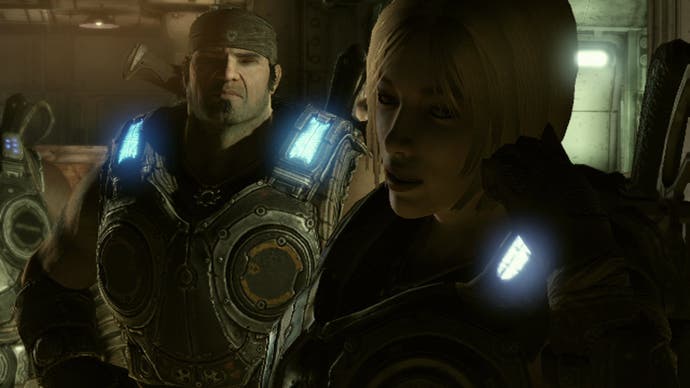
The other disadvantage of reprojection is that the coordinates of transparencies generally aren't available in the depth buffer, so with Enslaved and Batman: Arkham Asylum, some objects just hang in mid-air, with no sense of position in 3D space. As we've already discussed, Gears of War 3 is heavy on alpha effects and particles, and while there is an odd sense that occasionally something isn't quite right here (muzzle flashes appear to be curiously disconnected from the weapon, for example), the overall effect does suggest that the effects are being rendered with depth.
So technicalities aside, how does Gears of War 3 look in 3D? Is there any actual bonus to the gameplay itself with a stereoscopic view engaged? In the Eurogamer review, Johnny Minkley (one of the few to give the 3D mode a proper workout) notes that a cover-based shooter like this does gain from the depth that a 3D approach offers. Our perspective is that it is looks very cool, and is a superb tech demo for TriOviz on Unreal Engine 3, but in the cold light of day, it does amount to little more than an alternative display mode. Yes, there's more depth and more immersion, but 3D gaming needs more than "support" - it needs concepts and ideas that translate into something new and exciting that utilise what the technology is capable of. In short, a nice bonus, but there isn't the feel of a tailored 3D experience that you get in MotorStorm Apocalypse or Killzone 3, for example.


In conclusion, it's safe to say that Gears of War 3 is an enormous success on many levels. At its most fundamental level, it takes the existing gameplay formula and refines it into an experience that just feels great: you're never at odds with the controls, the action is fluid and intuitive, and there's an immense level of satisfaction in all aspects of the core mechanics. This might not sound like a big deal, but in reality it's the end product of a huge amount of work at the Epic studios.
On top of this, the new Gears is clearly the most technologically advanced Unreal Engine 3 game to date, pushing the technology in exciting new directions. As our videos have hopefully demonstrated, the lighting and VFX work is nothing short of phenomenal, while the new camera and object-based motion blur systems are the most refined we've seen from any game utilising the Epic tech: this is a 30FPS game but, similar to The Force Unleashed II, it looks and feels smoother. On top of this, the art direction is simply superb - the quality is so much improved over the previous Gears titles that a return visit serves to remind you of how much progress Epic has made over the course of this console generation.
The approach to campaign and multiplayer is also worthy of commendation. We finished a campaign mode run on the "normal" setting in around eight hours, but the inclusion of arcade variations plus the implementation of four-player co-op suggests that there's a mountain of replayability in there without even factoring what must surely be the most fleshed-out, comprehensive series of multiplayer game modes we've seen from the franchise. Epic seems to understand that complaining about pre-owned sales doesn't achieve anything: handing in a game that people won't want to trade in is the way forward.
Aside from the technical foibles - which by and large are minor - perhaps the greatest criticism that can be levelled at Gears of War 3 is precisely the point brought up in the Eurogamer review. Certainly in single-player mode, the campaign ebbs and flows in terms of pacing with sections of Act I in particular often feeling padded out, with samey shoot-outs shoehorned in between sparse plot progression, along with a prolonged character cameo which slows down the flow of the story somewhat.
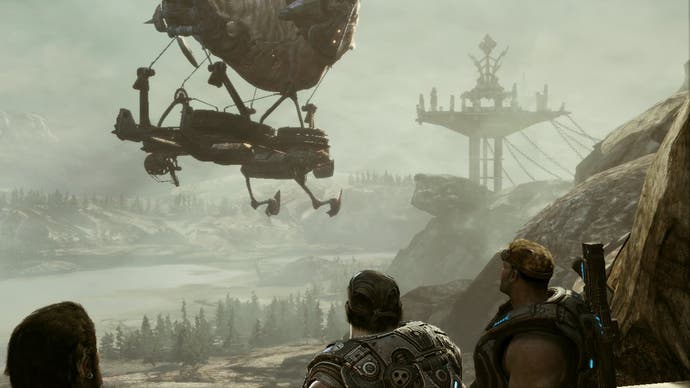
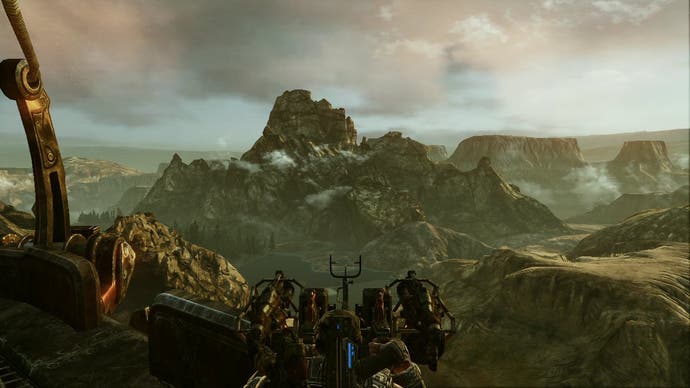
Things improve rapidly as the Act draws to a close and the campaign kicks up a notch - the set-pieces are spectacular, the action itself is consistently entertaining, but on the flipside, there's never a sense that the Gears gameplay template is being radically improved in the way that, say, Naughty Dog aimed to mix things up in Uncharted 2. You rarely feel challenged into trying something new, the same tactics generally just seem work from start to finish. In this sense, the eyes and ears are well taken care of, but the brain doesn't really get a workout.
If the lack of revolution is palpable, it's important to point out that players aren't being short-changed here - far from it. Gears of Wars 3 remains a remarkable product: the ultimate iteration of the formula backed up by state-of the-art console visuals, and a range of gameplay options that offers a superb amount of value. It's the best Xbox 360 exclusive we've seen for a long time, and is undeniably well worth your money.





